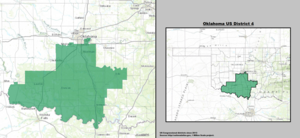| Name | Party | Years | Cong
ress | Electoral history | Location |
|---|
| District established November 16, 1907 |

Charles D. Carter
(Ardmore) | Democratic | November 16, 1907 –
March 3, 1915 | 60th
61st
62nd
63rd | Elected in 1907.
Re-elected in 1908.
Re-elected in 1910.
Re-elected in 1912.
Redistricted to the 3rd district . | |

William H. Murray
(Tishomingo) | Democratic | March 4, 1915 –
March 3, 1917 | 64th | Redistricted from the at-large district and re-elected in 1914.
Lost renomination. |

Tom D. McKeown
(Ada) | Democratic | March 4, 1917 –
March 3, 1921 | 65th
66th | Elected in 1916.
Re-elected in 1918.
Lost re-election. |

Joseph C. Pringey
(Chandler) | Republican | March 4, 1921 –
March 3, 1923 | 67th | Elected in 1920.
Lost re-election. |

Tom D. McKeown
(Ada) | Democratic | March 4, 1923 –
January 3, 1935 | 68th
69th
70th
71st
72nd
73rd | Again elected in 1922.
Re-elected in 1924.
Re-elected in 1926.
Re-elected in 1928.
Re-elected in 1930.
Re-elected in 1932.
Lost renomination. |

Percy Lee Gassaway
(Coalgate) | Democratic | January 3, 1935 –
January 3, 1937 | 74th | Elected in 1934.
Lost renomination. |

Lyle Boren
(Seminole) | Democratic | January 3, 1937 –
January 3, 1947 | 75th
76th
77th
78th
79th | Elected in 1936.
Re-elected in 1938.
Re-elected in 1940.
Re-elected in 1942.
Re-elected in 1944.
Lost renomination. |

Glen D. Johnson
(Okemah) | Democratic | January 3, 1947 –
January 3, 1949 | 80th | Elected in 1946.
Retired to run for U.S. Senator. |

Tom Steed
(Shawnee) | Democratic | January 3, 1949 –
January 3, 1981 | 81st
82nd
83rd
84th
85th
86th
87th
88th
89th
90th
91st
92nd
93rd
94th
95th
96th | Elected in 1948.
Re-elected in 1950.
Re-elected in 1952.
Re-elected in 1954.
Re-elected in 1956.
Re-elected in 1958.
Re-elected in 1960.
Re-elected in 1962.
Re-elected in 1964.
Re-elected in 1966.
Re-elected in 1968.
Re-elected in 1970.
Re-elected in 1972.
Re-elected in 1974.
Re-elected in 1976.
Re-elected in 1978.
Retired. |

Dave McCurdy
(Norman) | Democratic | January 3, 1981 –
January 3, 1995 | 97th
98th
99th
100th
101st
102nd
103rd | Elected in 1980.
Re-elected in 1982.
Re-elected in 1984.
Re-elected in 1986.
Re-elected in 1988.
Re-elected in 1990.
Re-elected in 1992.
Retired to run for U.S. Senator. |

J. C. Watts
(Norman) | Republican | January 3, 1995 –
January 3, 2003 | 104th
105th
106th
107th | Elected in 1994.
Re-elected in 1996.
Re-elected in 1998.
Re-elected in 2000.
Retired. |

Tom Cole
(Moore) | Republican | January 3, 2003 –
present | 108th
109th
110th
111th
112th
113th
114th
115th
116th
117th
118th
119th | Elected in 2002.
Re-elected in 2004.
Re-elected in 2006.
Re-elected in 2008.
Re-elected in 2010.
Re-elected in 2012.
Re-elected in 2014.
Re-elected in 2016.
Re-elected in 2018.
Re-elected in 2020.
Re-elected in 2022.
Re-elected in 2024. | 2003–2013  |
2013–2023  |
2023–present  |















